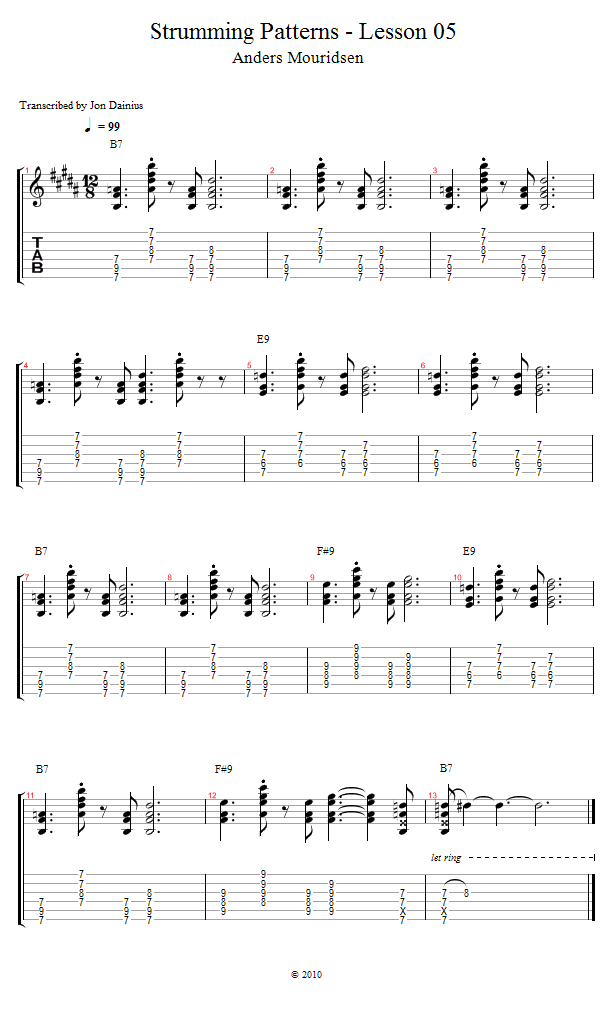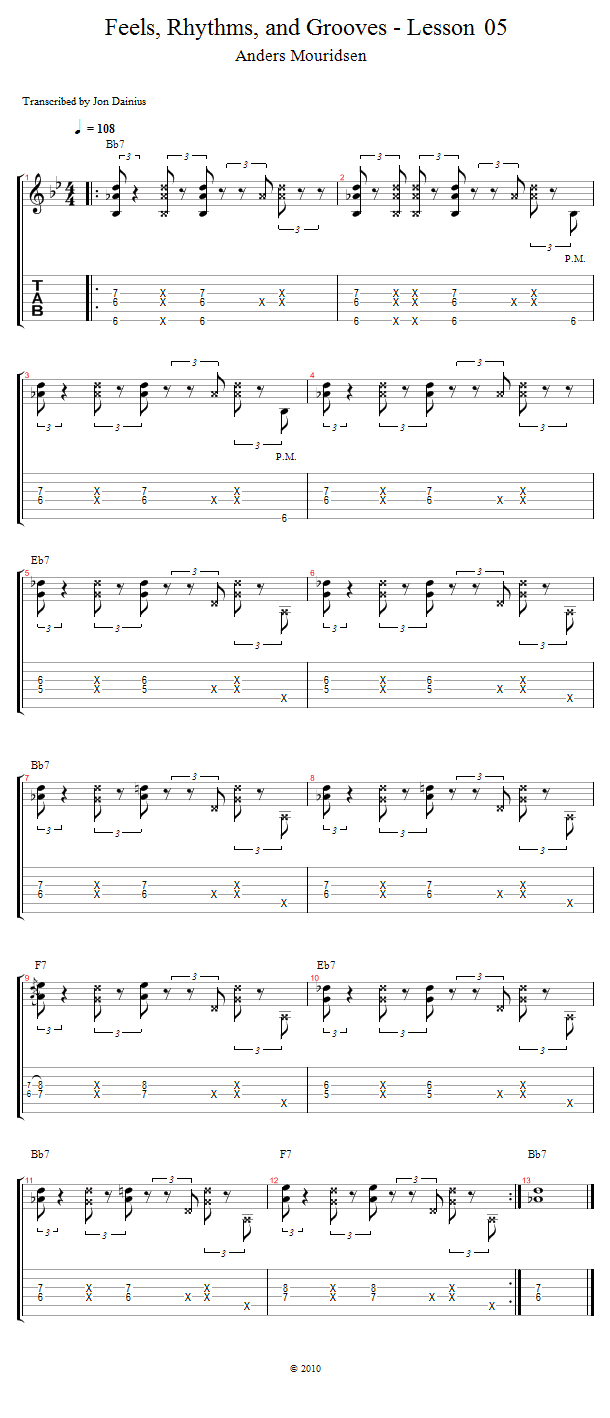Scottoro
Chapter 4: Blues Rhythm and Feel
Expand you knowledge and skill by learning new strumming patterns in the Blues style. Most importantly, the distinction between straight and swing feel. You’ll also get an introduction to various regional blues styles.
Tutorial: Blues Strumming Patterns
In this tutorial we’re going to focus on your right hand by breaking down a couple of really useful strumming patterns for the blues. Chord voicings and left hand technique is very important, but right hand chops and different rhythmic approaches are just as important!
Intro to Blues Strumming Patterns
It’s important to have a solid vocabulary of chords, riffs and left hand tricks, but it’s just as important to have a strong rhythmic feel and some good right hand chops! So in this tutorial we’re gonna look at some very useful strumming patterns that you’re gonna use again and again when you play the blues.
Meat, Potatoes, and Quarter Notes

In this lesson I’m going to show you a strumming pattern that I use a lot. It’s pretty busy and works best with a cleaner tone. I use the term “meat and potatoes” for this kind of rhythm guitar part, because it’s really heavy and solid. It’s a really good one to know, and it also works in other styles of music.
Strumming the Back Beats

In this lesson I’m gonna show you a strumming pattern that you can never go wrong with, which is strumming the “back beats” with the snare drum on beats 2 and 4. It works really well if you’re playing with another guitar player or a piano or organ player, but it might be too sparse if you’re the only harmonic instrument. Check it out!
Strumming the Upbeats

The next strumming pattern that I’m gonna show you is a very powerful one. The “upbeats” are the eight notes in between your 4 beats (“One AND two AND three AND four AND…”) and if you strum those you can drastically change the feel and sound of what the whole band is playing.
For example: If another player in your band is taking a solo, try to play this part the 2nd time around, and you will make him look like a million bucks!
Whole Notes With A Back Beat

When you play whole notes over a slow blues, it can get kind of boring. And if you only play the back beats, it will be too sparse. So in this lesson I’m gonna show you a strumming pattern that uses a little bit of both, and therefore works really well for a slow “6/8” blues.
Conclusion: Make Them Your Own
In this tutorial I’ve shown you a couple of my favorite strumming patterns; now it’s time for you to come up with your own. So pick any blues song that you have in your library and see if you can find a cool strumming pattern that works for it.
And remember that you can combine all of the patterns I’ve shown you today. For example, you can play whole notes on the I chord and back beats on the IV chord. Or you can play back beats the first time around when someone is soloing and play upbeats 2nd time around. Try out as many combinations as you can think of and remember the ones that work!
Tutorial: Feels, Rhythms, and Grooves
In this tutorial we’re going to look at three different rhythmic feels that are used in the blues. For each of these “grooves” I will explain what the drummer and the bass player are most likely to be playing, and I will show you a guitar part that fits it.
This will give you a good understanding of the different types of blues grooves and what to play over them!
Intro to Feels, Rhythms, and Grooves
Now that you’ve learned the basics of the blues, it’s time to look at the different “feels”, grooves and rhythms that are used in blues rhythm playing. We’re gonna play through examples of some of these different grooves and use chords and voicings that you already know.
Straight vs. Swing

In this lesson I’m gonna show you the difference between “swung” eight notes and “straight” eight notes. In the following lessons we’ll look at some examples of some “grooves” that use swung eight notes and some that use straight.
The Straight Feel

In this lesson I’ll show you a very typical example of a blues groove that uses straight eight notes. After I’ve shown you a fitting guitar part, we’re gonna rock it out with “the band”. Notice how the 12 bar form sounds more like old school rock ‘n’ roll with this rhythmic feel.
Introducing The Shuffle

In this lesson I’m gonna show you a very typical example of a blues groove that uses swung eight notes. It’s called a “Shuffle” and it’s a very heavy and “driving” groove. After I’ve shown you a fitting guitar part for this rhythmic feel, we’ll jam out with the backing track!
The Swing Feel

In this lesson I’m gonna show you another groove that uses swung eight notes, but this one is much “lighter” and jazzier than the shuffle. After I’ve shown you a fitting guitar part, we’re gonna try it out with the backing track!
Same Part, Different Grooves

In this lesson we’re gonna pick a part and see if we can make it work for all 3 grooves that we’ve covered so far, just by changing our rhythmic approach.
Conclusion: Call It What You Want
Everybody seems to have their own definitions of all the terms that we’ve used today, so don’t be frustrated it people tell you different things, because at the end of the day it all has to do with what you hear and what you play. Then you can call it whatever you want. We’re not lawyers, we’re musicians! So have fun with all the grooves and rhythms.
Tutorial: Intro to Regional Blues Styles
In this tutorial I will give you a brief explanation and a musical sample of some of the most well-known regional blues styles. I’m gonna introduce you to the sound of the acoustic Delta Blues, Chicago Blues, New Orleans Blues and more, so that you can start being aware of where the blues originated. Knowing some of the origins of the blues will help you determine what styles you like, and what your goal is with learning the basics of the blues.
Introduction to Regional Blues Styles
There are many completely different sounds under the umbrella of “Blues” and in this tutorial we’re gonna explore some of them. We’re gonna look explore the sound of Delta Blues, Chicago Blues, Texas Blues, New Orleans Blues, British Blues and Jazz Blues and hopefully by the end of this tutorial you’ll have a good idea of how many different places you can take this style of music. We’ll get into each of these regional blues styles in Level 2, so today is just a taste of what’s to come and hopefully and inspiration to explore some of these styles further on your own!
Delta Blues

In this lesson we’re gonna explore a really cool regional blues style, that was played in the Mississippi Delta by guys like Robert Johnson and Son House, and is a lot of fun to play. One of the coolest things about this style, is that you can play it completely by yourself. You don’t need a resonator guitar like the one I’m using- a regular acoustic will do just fine. You will need a slide though, but you can get those in any music store and they come in all materials, shapes and sizes. The higher the action on your guitar is, the easier it will be to play slide guitar.
Texas Blues

When most people hear the term Texas Blues, the first thing that comes to mind is the guitar playing of Stevie Ray Vaughan, but he wasn’t actually one of the inventors of this style- he was part of the revival in the 1980’s
In level 2 we’ll get into some of the origins of Texas Blues, but for now let me show you a little example of some Stevie Ray Vaughan style rhythm guitar. First I’ll break down the example for you, and then I’ll play through it with the authentic backing track. First time around, I’ll stick to the example and second time I’ll just go for it. Hopefully this will inspire you to keep at it!
Jazz Blues

In this lesson we’re going to explore the sounds that you get when you mix up blues and jazz sounds. I’m gonna introduce you to the slightly more elaborate “jazz blues 12 bar form” as well as some soloing concepts to listen for and try to use in this style.
If you like the sound of this style, check out players like Wes Montgomery, George Benson, Larry Carlton, and Robben Ford.
Chicago Blues

Chicago blues came about when over a million workers from The South migrated north to work at the factories in big cities like Chicago. They took their delta blues with them, but started using electric instruments, horn players, and jazzy harmony. It’s a really cool sound, and after introducing you to a couple of key elements in this sound, I’ll demonstrate it with a Chicago-style backing track.
If you like the sound of this style check out artists like Muddy Waters, Howlin’ Wolf, Buddy Guy, Freddie King, Elmore James, and Paul Butterfield.
New Orleans Blues

New Orleans blues is another really cool regional blues style that mainly has to do with the way drums, piano, and horns are played. But in this tutorial I’ll give you a brief introduction to the style with it’s Afro-Cuban influence, the jazzy harmony and greasy grooves and finally I’ll demonstrate the sound for you with a groovin’ backing track.
If you like the sound of this style, check out artists like The Meters, Dr. John, Professor Longhair, Guitar Slim, and Allen Toussaint.
British Blues

In this lesson I’ll show you what British blues sounds like. We’ll talk about the orchestration, rhythm, and lead playing that you hear in this style, and at the end I’ll demonstrate it for you with a rockin’ backing track!
If you like the sound of it, check out John Mayall and The Blues Breakers with Eric Clapton, Peter Green, and Mick Taylor.
Conclusion to Regional Blues Styles
I hope this introduction to the different regional blues styles has peaked your interest so that you’ll keep working on your blues chops, listen to a lot of blues records, and continue on to Blues Level 2 here on Guitar Tricks!